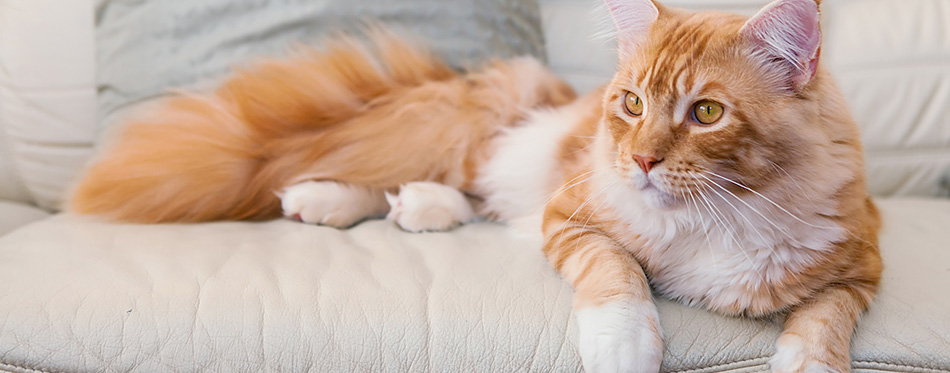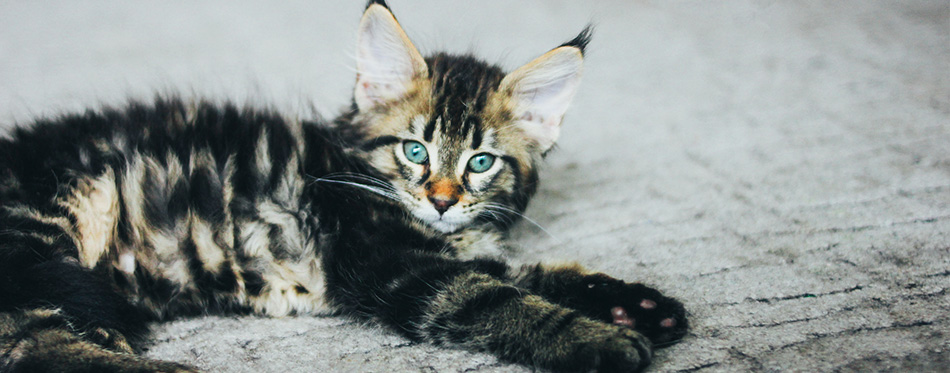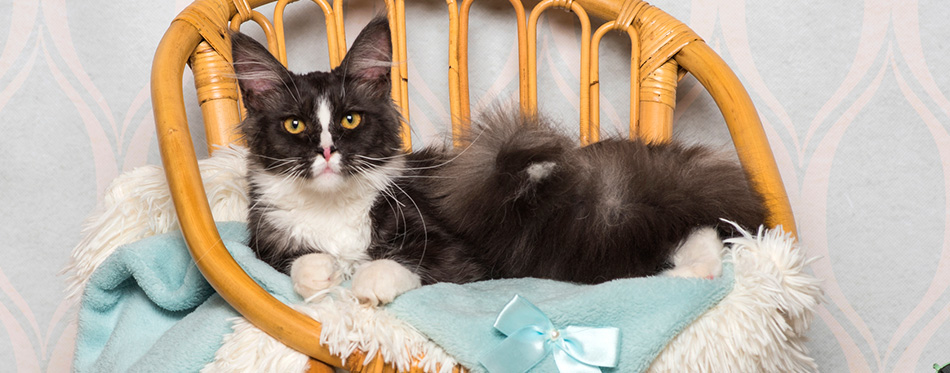They’re big and heavy, and they have the look of a ferocious wild feline you don’t want to encounter in the jungle. Yet what many people don’t know about this large cat is that it has a gentle heart and an affectionate nature. This is the Maine Coon, one of North America’s oldest natural breeds. And while there are conflicting accounts as to how this kitty ended up on the continent, the cat-loving world is one in saying that this is one of the best kitties to have as a pet. It has a very sociable temperament that is favorable among cat-averse staunch dog-lovers. It’s got dainty britches, a big bushy tail, a beautiful neck ruff, and snowshoe-like tufted limbs. If one is looking for a feline gentle giant that has dog-like characteristics, then the Maine Coon fits the bill.

History of the Maine Coon
There are only bits and pieces of folk tales, legends, and speculations as to how the Maine Coon came about. One of the more popular ones involves then-Queen of France, Marie Antoinette. Marie Antoinette sought the assistance of Captain Samuel Clough in an attempt to escape France and reach the New World in June 1791. Clough loaded Marie Antoinette’s most prized possessions in his ship. This included 6 of Marie Antoinette’s favorite Turkish Angoras. Unfortunately, Marie Antoinette and her royal family never got to escape. Her possessions did arrive in Wiscasset, Maine, however. The story has it that Marie Antoinette’s Turkish Angoras mated with the native shorthaired feline breeds in Maine to produce what we now call the Maine Coon.
Another story is that of an English seafarer who was known for keeping longhaired felines aboard his ship. Every time Captain Charles Coon’s ship anchors in one of New England’s ports, his longhaired kitties would disembark, too. They would explore the port and its immediate surroundings before they set sail again. Coon’s cats interacted and mated with local feral cats. Local townspeople began noticing the increasing number of longhaired kittens in their town, which they referred to these as Coon’s cats.
Somebody also forwarded the hypothesis that the Maine Coon is the result of mating between a domestic cat and a wild animal.
The first of these myths involves a raccoon and a semi-feral domestic cat. The idea behind this proposition is the observation that Maine Coons have a bushy tail and a brown tabby color. The bushy tail is very characteristic of a raccoon, while the brown tabby is what you can expect from majority of domestic cats. Unfortunately, mating a cat with a raccoon was unheard of at the time. The second hypothesis involves the mating between a domestic cat and a wild bobtail. This should account for the tufts of hair that Main Coons are famous for on the tips of their ears. Again, this might not be possible at the time.
Maine Coon fanciers accept the idea that their favorite kitty has its origins in the mating between local Maine domestic felines and European longhaired breeds. The longhaired cats may have been brought to American shores by English seafarers or by 11th century Scandinavian Vikings or Norsemen. The latter provides a more credible proof to the origins of the Maine Coon.
As Norsemen reached American shores, they brought with them Norwegian Forest Cats. These felines have a surprising resemblance with the Maine Coon. This gives credence to the belief that these Norsemen felines have something to do with the creation of the Coon.
Wherever the Maine Coon originated, this is a cat that is well-revered for its mousing skills.
It was F.R. Pierce who wrote a chapter about these cats in the 1861 Frances Simpson literature titled, The Book of the Cat. By the late 1860s, local Maine farmers were already holding competitions for the Maine State Champion Coon Cat.
In 1985, the breed first entered a cat show in Boston before joining again in the very first cat show in North America. The latter was held at the Madison Square Garden where Cosey, a Coon brown tabby, won the Best in Show along with a silver medal and collar.
At the turn of the 20th century, Maine Coon cats’ popularity fell with the concomitant rise to fame of other longhaired breeds like the Persian. The last national cat show where the Maine Coon won was in 1911 in Portland. After that show, the breed went into a rapid decline. By the 1950s, the cat breed was already thought to have gone extinct; although this was often considered an exaggeration of the fact.
In the early 1950s, Ethyllin Whittemore, Ruby Dyer, and Alta Smith collaborated to establish the Central Maine Cat Club or CMCC. The club aimed to increase the breed’s popularity by holding cat shows and hosting Maine Coon photo exhibits. The group also created the standards of the Maine Coon breed.
Unfortunately, the Cat Fanciers’ Association denied giving provisional breed status to the Maine Coon for a record three times. The Maine Coon Cat Club was, thus, formed in 1973 to further improve the standards of the feline breed.
Two years later, the CFA granted provisional breed status to the Maine Coon. A year later, in May 1 1976, the Maine Coon was granted championship status. Over the decades, the breed came home with championship victories which also saw its popularity rise again.
The state of Maine adopted the Maine Coon as its official state cat in 1985. As of 2018, the CFA ranks the Maine Coon as the world’s 5th most popular cat breed.
Quick Facts About the Maine Coon
Coons are large cats that bear a strong resemblance to the Norwegian Forest Cat. It is a giant among feline breeds, but has a very gentle temperament that is quite unheard of in the cat kingdom. If the Great Dane is the gentle giant in the dog world, then the Maine Coon is its feline counterpart. These are some of the more fascinating things about the Coon. Here are the other facts that you need to know about.
- Coons are heavyweight felines that can weigh up to 20 lbs. There are reports of 30-lb Coons, but these are more a reflection of feline obesity than the normal healthy weight of cats. Females are always lighter than males, with their maximum healthy weight pegged at 12 lbs.
- These cats are also tall as they are long. Adult Coons can grow as tall as 16 inches and as long as 48 inches from the tip of their nose to the tip of their tail. The tail itself can reach a staggering length of 14 inches.
- One of the hallmark physical characteristics of a Coon is its tail. It resembles that of a raccoon’s tail.
- Coons have a solid and muscular body, allowing it to support the cat’s weight.
- Maine Coons are slow to mature, often taking 3 to 5 years before they reach their full adult size.
- The “longest” cat in the Guinness Book of World Records is a 48.5-inch long Maine Coon named Stewie.
- This cat can have a medium-length or long hair. It is silky and soft. It has an undercoat, but is not as dense as the undercoat of other cats.
- The coat is shorter on the coon’s head and shoulders. It is longer on the sides and the cat’s tummy.
- Coon coats undergo seasonal variation. It is thin in the summer and thick in the winter.
- Another characteristic feature of the Coon is a lion-like neck ruff.
- The most common color pattern is brown tabby. They can come in different colors that other cat breeds have. However, some of these color patterns are not recognized by certain cat organizations.
- Maine Coons have dog-like characteristics such as easy to train, sociability, loyalty, and affectionate nature.
- These cats are very vocal. Aside from the classic meow, Coons can also yowl, howl, chirp, trill, and do other loud feline vocalizations.
- Coons love the water. This is a trait that fanciers say the breed got from its seagoing ancestors.
- These cats have a unique way of telling you how special you are to it. It will do a nice head butt.
- Maine Coons can live anywhere between 9 and 15 years.

Things You Should Know
It is obvious that the Maine Coon is a very special cat requiring special care and attention. If you decide to bring this gentle feline giant home, then you should keep yourself well-versed with the following essentials.
Health
Maine Coons lead healthy lives, often reaching up to 15 years or more. However, they are not immune to some of the diseases that are common among all cats. These can include Hypertrophic Cardiomyopathy (HCM) and Polycystic Kidney Disease (PKD).
The incidence of HCM in Maine Coons is about 1 in 10. Coons that are already in their middle age are more susceptible to HCM than younger cats. The disease can bring about heart failure and rear leg paralysis. The paralysis occurs because of blood clot embolization. This can lead to the Coon’s sudden death.
On the other hand, the incidence of PKD among Coons is a bit low. However, this doesn’t mean that it cannot occur in the cat. PKD can result in the destruction of functional tissues of the kidneys. In other words, the cat may no longer be able to filter blood and remove toxic metabolites from its body.
A more pressing health problem among Maine Coons is Spinal Muscular Atrophy (SMA). This condition presents as muscle weakness and muscle atrophy because of the death of the motor neurons in the cat’s spinal cord. The cat may also have a shorter life span.
Hip Dysplasia is another condition that is quite common in Maine Coon cats. The current estimate of hip dysplasia incidence is at 24%. What this means is that almost 1 of 4 Coons can have dysplastic hip joints. This is quite excepted since the cat is large and heavy. Its weight can also hasten the deterioration of the hip joints, leading to arthritis and problems in mobility.
Feeding
Owing to its muscular body and high energy levels, the Maine Coon requires plenty of protein and nutrients in its diet. When it comes to protein sources, meats provide the best. These already come with all the essential amino acids that Maine Coons and other cats need. This includes taurine, an amino acid that can help ensure the healthy development of the cat’s heart.
High-quality, premium raw foods are the best diets for Maine Coons. However, because of the relative difficulty of sourcing safe and high-quality raw cat food, the next best option will be to give home-cooked cat food. In preparing such kitty meals, it’s important to adhere to the animal protein-first principle. The main ingredient should always be high-quality meat-based protein. One should also do away with unnecessary and unsafe spices, herbs, and other ingredients.
An easier option will be to offer high-quality wet cat food that lists a named animal protein as its first ingredient. Some may give pet kibbles, but these are calorie-dense. You might end up with an obese Coon.
Take note of the nutrient content of the cat food. One out of four Coons can have hip dysplasia. Giving joint-friendly supplements like chondroitin and glucosamine can help.
For more guides on choosing the right cat food, you may wish to check out our reviews of the best wet cat food, senior cat food, hypoallergenic cat food, cat food for hairballs and cat food for weight loss.
Care
Caring for the Maine Coon involves protecting it against common feline diseases through vaccination. Regular trips to the vet clinic are also a fundamental requirement for their optimum care. Vets can perform a more thorough evaluation of the Coon’s health status so that more appropriate measures can be initiated.
Clean the Coon’s litter box at least once a week. No cat would ever want to eliminate in a toilet that stinks. It would be ideal to have at least two litter boxes in the house so the cat has an alternative in case you haven’t cleaned the other one yet.
Since the Coon may also develop kidney problems, it is best to encourage it to drink lots of water. Using cat water fountains can help entice the Maine Coon to drink more. Adding catnip, ice cubes, or a few drops of tuna broth in the cat’s water also help.
Keep the Maine Coon as an indoor-only cat. If you have to bring it outside, make sure that it is on a leash or you can guarantee 100% supervision. This is not a cheap breed. Maine Coon mixes can sell for about $50 to $100. Purebred Coons, on the other hand, can cost up to $2,000. You do not want to lose this expensive cat to cat thieves or accidents in the outdoors.
Take a look at our reviews of Brushes For Cats and Cat Toothpaste.
Grooming
The Maine Coon is very easy to groom. This is despite the fact that it can have a thick, long coat. The beauty of this cat is that its undercoat is less dense than what other cats have. This makes brushing and combing a breeze. It is also not easy to tangle or form mats. However, this doesn’t mean you can start neglecting the Coon. It still requires periodic, twice-weekly brushing to remove dead skin cells, improve blood circulation, and redistribute natural skin oils.
Dental care is an absolute must for the Maine Coon. It requires at least thrice-weekly brushing of the teeth and an annual trip to a veterinary dentist. As for its ears, inspection and cleaning can occur every 2 weeks. Trimming its nails is also important. It may already have a scratching post, but its nails still require trimming once every 3 weeks.
For more help on cat grooming, you may wish to read our guides on the best cat ear cleaners, cat nail clippers, brushes for cats, cat grooming gloves, cat nail caps and cat shampoos.

Temperament
Despite its gigantic size and a fearsome look, the Maine Coon is as gentle and sweet as a cuddly Teddy bear. This is a sociable and amiable cat, relishing the friendship and companionship that its people provide. And if you do have other pets at home, the Maine Coon can be their friend, too; unless you have small pets like guinea pigs, white rats, and hamsters. The Coon is a prolific “mouser”; hence, it will try to eliminate these “small animals” from your home.
Like the Great Dane, the Maine Coon doesn’t consider its size as an obstacle to becoming a lap cat. And what a large lap cat the Coon can be. It has this insatiable curiosity to learn more about what its owner is doing. It follows him throughout the house. It doesn’t demand or beg for attention but it would be difficult not to give in to the cat’s endearing ways. Plus, there’s no ignoring its looks and its size.
Some say the Coon has above-average intelligence. Coon fanciers, on the other hand, say that this breed is smart. Play fetch with it or teach it to walk with confidence on a leash. It loves the water; hence, having a swimming pool in your backyard will sure come in handy. Water-related activities are some of the best ways you can get this cat to exercise.
The Maine Coon is an adorable and affectionate cat; albeit large for a lap cat. It is a great pet for those who want a cat with dog-like characteristics and one that looks as exotic as the Norwegian Forest Cat. Make sure you understand what it takes before you bring a Coon home.
Sources:
- Maine Coon Cat Breed – PetMD
- About the Maine Coon Cat – CFA

